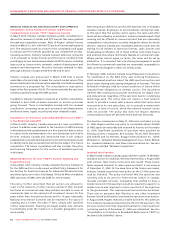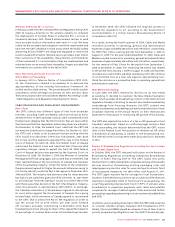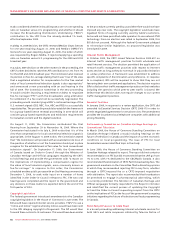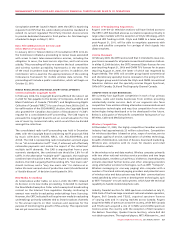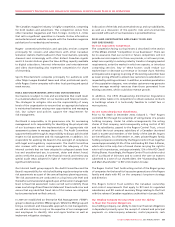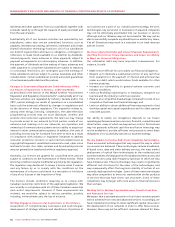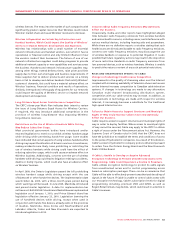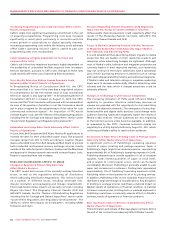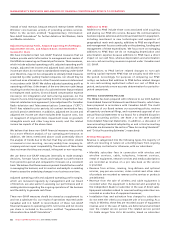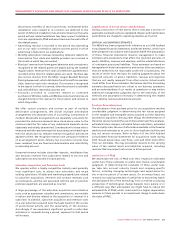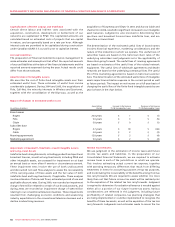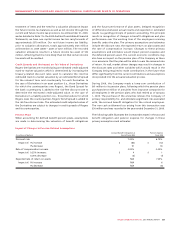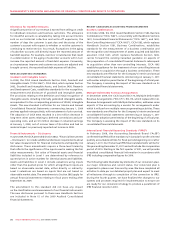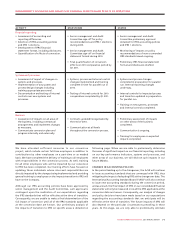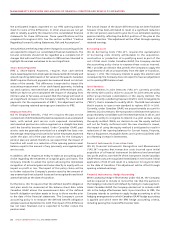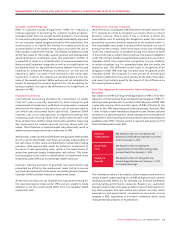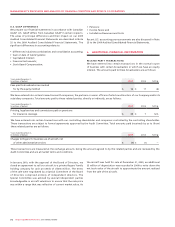Rogers 2009 Annual Report Download - page 60
Download and view the complete annual report
Please find page 60 of the 2009 Rogers annual report below. You can navigate through the pages in the report by either clicking on the pages listed below, or by using the keyword search tool below to find specific information within the annual report.
64 ROGERS COMMUNICATIONS INC. 2009 ANNUAL REPORT
MANAGEMENT’S DISCUSSION AND ANALYSIS OF FINANCIAL CONDITION AND RESULTS OF OPERATIONS
Increasing Programming Costs Could Adversely Affect Cable’s
Results of Operations.
Cable’s single most significant purchasing commitment is the cost
of acquiring programming. Programming costs have increased
significantly in recent years, particularly in connection with the
recent growth in subscriptions to digital specialty channels.
Increasing programming costs within the industry could adversely
affect Cable’s operating results if Cable is unable to pass such
programming costs on to its subscribers.
Cable Telephony is Highly Dependent on Facilities and
Services of the ILECs.
Cable’s out-of-territory telephony business is highly-dependent on
the availability of unbundled facilities acquired from incumbent
telecom operators, pursuant to CRTC rules. Changes to these rules
could severely affect the cost of operating these businesses.
Over-the-Air Television Station Licence Renewals Could
Adversely Affect Cable’s Results of Operations.
In Broadcasting Notice of Consultation 2009-411, the CRTC
announced that it is “now of the view that a negotiated solution
for compensation for the free market value of local conventional
television signals is also appropriate”. In Broadcasting Notice of
Consultation 2009-411-3 released on August 11, 2009, the CRTC
announced that “the Commission will proceed with an examination
de novo of the question of whether or not the Commission should
put in place a regime for the establishment of fair value for local
conventional television signals”. An imposition of FFC would
increase Rogers’ costs. See the “Review of Broadcasting Regulations
including Fee-for-Carriage and Distant Signal Fees” section under
“Government Regulation and Regulatory Developments”.
Unbundled Local Loop Rates Could Adversely Affect Cable’s
Results of Operations.
In June 2009, Bell Canada and Bell Aliant filed tariff applications to
increase the rates for their unbundled copper loops. The proposed
increases range from 25% to 100% according to location. Rogers
leases unbundled loops from Bell Canada and Bell Aliant to provide
both residential and business primary exchange services, mostly
outside of the cable footprint in Ontario, Quebec and the Maritimes
and approval of these proposed rates would increase Rogers’ costs.
Rogers is opposing these rate increases.
RISKS AND UNCERTAINTIES SPECIFIC TO MEDIA
Changes in Regulatory Policies May Adversely
Affect Media’s Business.
The CRTC conducted a review of the specialty and pay television
sector, as well as the regulations affecting all distributors
(the Broadcasting Distribution Regulations). This review focused
on a number of different issues, including wholesale fees,
dispute resolution and packaging and linkage requirements.
This broad-based review impacts all specialty services, including
Rogers Sportsnet, The Biography Channel Canada, OLN and
G4TechTV Canada. See the “Review of Broadcasting Regulations
including Fee-for-Carriage and Distant Signal Fees” section under
“Government Regulation and Regulatory Developments”. The
ability to collect fees impacts all broadcasters, including OMNI
Television and Citytv.
Pressures Regarding Channel Placement Could Negatively
Impact the Tier Status of Certain of Media’s Channels.
Unfavourable channel placement could negatively affect the
results of The Shopping Channel, Sportsnet, G4TechTV, The
Biography Channel Canada and OLN.
A Loss in Media’s Leadership Position in Radio, Television
or Magazine Readership Could Adversely Impact Media’s
Sales Volumes and Advertising Rates.
It is well established that advertising dollars migrate to media
properties that are leaders in their respective markets and
categories when advertising budgets are tightened. Although
most of Media’s radio, television and magazine properties are
currently leaders in their respective markets, such leadership
may not continue in the future. Advertisers base a substantial
part of their purchasing decisions on statistics such as ratings
and readership generated by industry associations and agencies.
If Media’s radio and television ratings or magazine readership
levels were to decrease substantially, Media’s advertising sales
volumes and the rates which it charges advertisers could be
adversely affected.
Changes in Technology Could Increase Competition.
The increasing utilization of PVRs could influence Media’s
capability to generate television advertising revenues as
viewers are provided with the opportunity to skip advertising
aired on the television networks. The emergence of subscriber-
based satellite and digital radio products could change radio
audience listening habits and negatively impact the results of
Media’s radio stations. Certain audiences are also migrating
to the Internet as more video becomes available. In addition,
as mandated by the CRTC, Canadian television signals are
migrating to a strictly digital platform by August 31, 2011, which
could impact Media’s ability to reach certain audiences.
An Increase in Paper Prices, Printing Costs or Postage Could
Adversely Affect Media’s Results of Operations.
A significant portion of Publishing’s operating expenses
consists of paper, printing and postage expenses. Paper is
Publishing’s single largest raw material expense, representing
approximately 8% of Publishing’s operating expenses in 2009.
Publishing depends upon outside suppliers for all of its paper
supplies, holds limited quantities of paper in stock itself,
and is unable to control paper prices, which can fluctuate
considerably. Moreover, Publishing is generally unable to pass
paper cost increases on to customers. Printing costs represented
approximately 12% of Publishing’s operating expenses in 2009.
Publishing relies on third parties for all of its printing services.
In addition, Publishing relies on the Canadian Postal Service to
distribute a large percentage of its publications. Any disruption
in printing or postage services could have a material impact on
Media’s results of operations or financial condition. A material
increase in paper prices, printing costs or postage expenses to
Publishing could have a materially adverse effect on Media’s
business, results of operations or financial condition.
Blue Jays Player Contract Activity Could Adversely Affect
Media’s Results of Operations.
The termination and release of Blue Jays player contracts before
the end of the contract term adversely affects Media’s results.


